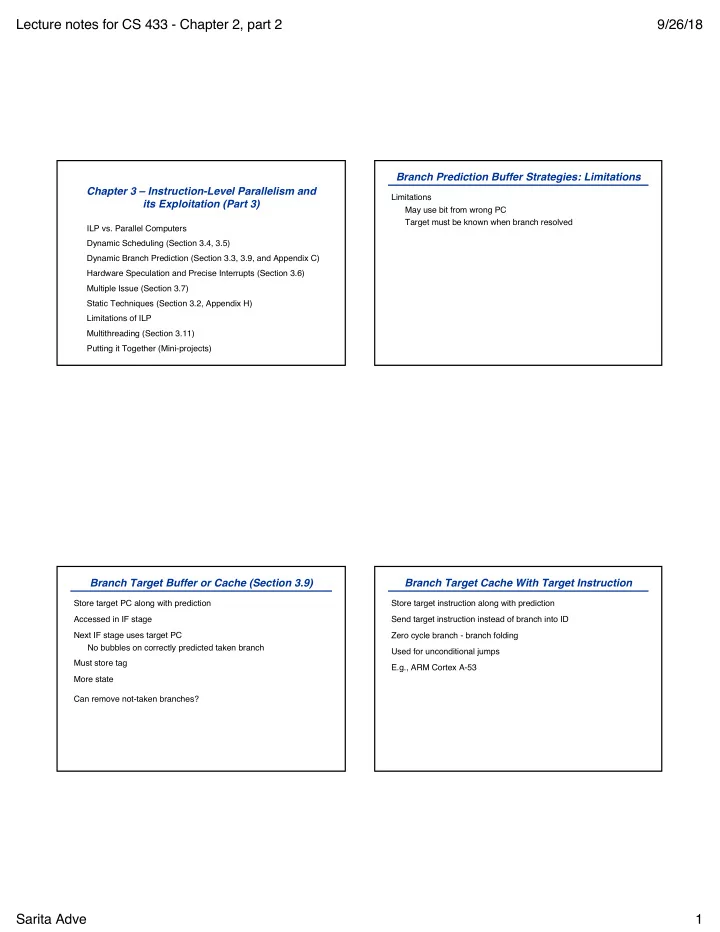

Lecture notes for CS 433 - Chapter 2, part 2 9/26/18 Branch Prediction Buffer Strategies: Limitations Chapter 3 – Instruction-Level Parallelism and Limitations its Exploitation (Part 3) May use bit from wrong PC Target must be known when branch resolved ILP vs. Parallel Computers Dynamic Scheduling (Section 3.4, 3.5) Dynamic Branch Prediction (Section 3.3, 3.9, and Appendix C) Hardware Speculation and Precise Interrupts (Section 3.6) Multiple Issue (Section 3.7) Static Techniques (Section 3.2, Appendix H) Limitations of ILP Multithreading (Section 3.11) Putting it Together (Mini-projects) Branch Target Buffer or Cache (Section 3.9) Branch Target Cache With Target Instruction Store target PC along with prediction Store target instruction along with prediction Accessed in IF stage Send target instruction instead of branch into ID Next IF stage uses target PC Zero cycle branch - branch folding No bubbles on correctly predicted taken branch Used for unconditional jumps Must store tag E.g., ARM Cortex A-53 More state Can remove not-taken branches? Sarita Adve 1
Lecture notes for CS 433 - Chapter 2, part 2 9/26/18 Return Address Stack (Section 3.9) Speculative Execution Hardware stack for addresses for returns How far can we go with branch prediction? Speculative fetch? Call pushes return address in stack Speculative issue? Return pops the address Speculative execution? Perfect prediction if stack length ³ call depth Speculative write? Speculative Execution Reorder Buffer Allows instructions after branch to execute before knowing if branch Overview will be taken Instructions complete out-of-order Reorder buffer reorganizes instructions Must be able to undo if branch is not taken Modify state in-order Often try to combine with dynamic scheduling Key insight: Split Write stage into Complete and Commit Entry Busy Type Dest Result State Excep Complete out of order 1 0 2 1 LD 4 Exec 0 No state update head 3 1 BR Exec 0 Commit in order 4 1 ADD 6 75 Compl 0 tail 5 0 State updated (instruction no longer speculative) 0 Use reorder buffer N 0 Instruction tag now is reorder buffer entry Sarita Adve 2
Lecture notes for CS 433 - Chapter 2, part 2 9/26/18 Re-order Buffer Pipeline Precise Interrupts Again Precise interrupts hard with dynamic scheduling Issue: Consider our canonical code fragment: LF F6,34(R2) LF F2,45(R3) Execute: MULTF F0,F2,F4 SUBF F8,F6,F2 DIVF F10,F0,F6 ADDF F6,F8,F2 Complete: What happens if DIVF causes an interrupt? ADDF has already completed Out-of-order completion makes interrupts hard But reorder buffer can help! Commit: Reorder Buffer for Precise Interrupts Re-order Buffer Drawback Operands need to be read from reorder buffer or registers Alternative: Rename registers Sarita Adve 3
Lecture notes for CS 433 - Chapter 2, part 2 9/26/18 Rename Registers + Reorder Buffer Many current machines More physical registers than logical registers Reorder buffer does not have values Read all values from registers Rename mechanism Rename map stores mapping from logical to physical registers (Logical register Rl mapped to physical register Rp) On issue, Rl mapped to Rp-new On completion, write to Rp-new On commit, old mapping of Rl discarded (free Rp-old) On misprediction, new mapping of Rl discarded (free Rp-new) Sarita Adve 4
Recommend
More recommend